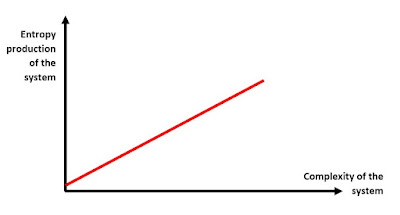- Part I introduces the theory
- Part II reports how this theory translate into human society organizations and behaviours
- Part III tries to report some historical events that fit into this discourse.
From thermodynamic point of view the social structure is a dissipative system. As all dissipative system, its final target is to maximize entropy production. Given a fixed flow of external energy input to the system, the system choses the internal structure (among infinite possibilities) that maximize the entropy production. The entropy production is directly proportional to the system complexity.
 |
| Entropy-complexity direct relation in societal organization |
Figure above points out that the maximum entropy dissipation is achieved by increasing the complexity of the system. If a society has more resource than another society, system dynamics tell us that the first society will be more complex than the other.
Now, let’s analyse better what we mean with complexity. Joseph Tainter defines system complexity as differentiation and organization of the parts of a system, the more differentiated and specialized each part and the more complex the structure. According to Tainter definition, and to introduce following posts, I break down complexity of a society in 3 different features: Size, Consumption and Stocks
A large size system is a more complex structure than a smaller one, so the energy consumes to keep it functioning are higher. Next posts will focus about kingdoms that rise fall, not exactly as in a famous U2 song. But also, we will see how the consumption of resources of the system parts (organization, companies, people) is directly related to the entropy production, and so is the resource stock generation.

Nessun commento:
Posta un commento